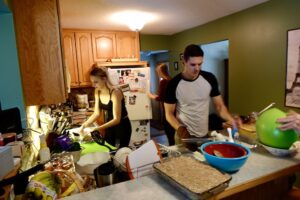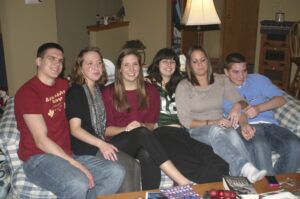 This Thanksgiving will be a different kind of celebration with same meaning as ever. Traditionally Native Americans saved Pilgrims from starvation back in 1620 by teaching them to tap maple trees, plant corn and fertilize soil.
This Thanksgiving will be a different kind of celebration with same meaning as ever. Traditionally Native Americans saved Pilgrims from starvation back in 1620 by teaching them to tap maple trees, plant corn and fertilize soil.
T-giving has always been a day of gathering bounty from fields, sharing with others, and giving thanks. However, this year, due to the pandemic, families should celebrate separately, which to Americans sort of defeats the whole purpose of T-day.
Ever since I moved to Europe forty years ago, I have been trying to thank my European hosts for accepting me into their countries. But not matter how I try to explain it, they remain bewildered by our Thanksgiving, a journée de remerciements. They think it is the only day of the year where Americans prepare a hot meal and eat slow food.
 My first year abroad I invited French teammates and they ate the food in courses, one dish at a time. The next year in Germany, the team turnout was so great, there was standing room only; we never sat down to dine. Another year French relatives replaced the giant Tom Turkey with Chicken Little. Now living in Switzerland off I go again every November on the Great Turkey Hunt through the Swiss Alps.
My first year abroad I invited French teammates and they ate the food in courses, one dish at a time. The next year in Germany, the team turnout was so great, there was standing room only; we never sat down to dine. Another year French relatives replaced the giant Tom Turkey with Chicken Little. Now living in Switzerland off I go again every November on the Great Turkey Hunt through the Swiss Alps.
 Last year I didn’t have to explain anything when Gerald and I celebrated our first extra special Thanksgiving in the states with our kids and sister and her family. My brother in law smoked a turkey, my son and daughter in law made a British speciality Yorkshire pudding, my niece added a broccoli salad. My sister brought the traditional pumpkin pie and my daughter contributed a gluten free apple crumble.
Last year I didn’t have to explain anything when Gerald and I celebrated our first extra special Thanksgiving in the states with our kids and sister and her family. My brother in law smoked a turkey, my son and daughter in law made a British speciality Yorkshire pudding, my niece added a broccoli salad. My sister brought the traditional pumpkin pie and my daughter contributed a gluten free apple crumble.
This year still in recovery from brain injury and like so many others dealing with Covid depression; I lament to my psychotherapist, “I am so sad, I can’t see family.”
“But isn’t the meaning of the Thanksgiving holiday to give thanks?” she reminds me. “Can you reframe your perspective and focus on what you do have to be grateful for?”
“Even though you can’t see your family, are they safe? Healthy?” She asks. “Is your husband still with you? Are you recovering?”
So many people have lost cherished family members and dear friends. Thanksgiving 2020 must be marked in different ways. I will start by celebrating with my loved ones in a Zoom call to surprise my parents.
At a safe distance separated from each other one end of an extended to hold a dozen people we will social distance and share a simplified T-Day. We will lift our glasses with a neighbor couple, part of our pod here, and I will whisper thanks for :
1. Health care workers worldwide who continue to battle a devastating pandemic.
2. Family who remain steadfast and loving for the long haul.
3. Friendships that sustain my spirit in hard times.
4. Frenchman – my life partner who picks me and puts me together after every fall.
5. Internet that instantly connects me between continents, cultures and time zones.
6. Words- books, cards, emails, calls that keep us connected especially now when we cannot reach out physically,
7. Summit Lake a place to dream of returning one day where sacred waters restore my soul.

This year in our modified Thanksgiving, we won’t dine on a whole Tom Turkey, just a turkey breast and though it will be a small, subdued celebration unlike the big noisy gatherings of Thanksgivings growing up in America, the blessings will be the same. The bird is secondary. It’s the stuffing — family, friends and memories — sharing and caring — that sustains me.






 Even though Biden was officially announced the 46th President of the United States, I remain suspended in space. The free floating anxiety I have felt since the Covid outbreak last March lingers because Trump refuses to concede. In our democracy! Instead he demands vote recounts, shouts election fraud and continues to give free license to supremacist white groups and other dangerous organizations. Militias pop up across the country, protests break out and even though I live 4,000 miles away, I am not sleeping.
Even though Biden was officially announced the 46th President of the United States, I remain suspended in space. The free floating anxiety I have felt since the Covid outbreak last March lingers because Trump refuses to concede. In our democracy! Instead he demands vote recounts, shouts election fraud and continues to give free license to supremacist white groups and other dangerous organizations. Militias pop up across the country, protests break out and even though I live 4,000 miles away, I am not sleeping.
 "And to the children of our country, regardless of your gender, our country has sent you a clear message: dream with ambition, lead with conviction and see yourself in a way that others might not see you, simply because they've never seen it before. And we will applaud you every step of the way.”
"And to the children of our country, regardless of your gender, our country has sent you a clear message: dream with ambition, lead with conviction and see yourself in a way that others might not see you, simply because they've never seen it before. And we will applaud you every step of the way.” register and vote. As I went through the necessary paperwork, I applauded those suffragettes who came before me and fought so hard to earn the right to vote.
register and vote. As I went through the necessary paperwork, I applauded those suffragettes who came before me and fought so hard to earn the right to vote.
 Living in Switzerland, all of Europe beckons from our backdoor, but any travel with my bad back remains challenging. So for our vacation, we narrowed our choice to a short (by American standards) four and half hour drive to discover Occitanie Region, a gem in south central France.
Living in Switzerland, all of Europe beckons from our backdoor, but any travel with my bad back remains challenging. So for our vacation, we narrowed our choice to a short (by American standards) four and half hour drive to discover Occitanie Region, a gem in south central France. .
.

 High above the gritty working port, we overlooked the red tile rooftops and admired the restless sea. We felt we’d found the best spot in town to discover the city and surroundings. That evening while winds rattled our shutters, and cicadas serenaded us to sleep, we couldn’t wait to throw open our shutters on a new day and begin exploring.
High above the gritty working port, we overlooked the red tile rooftops and admired the restless sea. We felt we’d found the best spot in town to discover the city and surroundings. That evening while winds rattled our shutters, and cicadas serenaded us to sleep, we couldn’t wait to throw open our shutters on a new day and begin exploring.
 As Covid rises around the globe, and holiday plans are derailed again, we wonder when we will be reunited with loved ones, but for expats living abroad, the pain of separation is magnified by distance. I ache to be with my family so much it feels like a limb is missing.
As Covid rises around the globe, and holiday plans are derailed again, we wonder when we will be reunited with loved ones, but for expats living abroad, the pain of separation is magnified by distance. I ache to be with my family so much it feels like a limb is missing.





 From a childhood growing up in a river town, to summers spent on a Wisconsin lake, to weekends of young adulthood walking Normand beaches to raising a family in a Switzerland with a view of Lake Geneva, no matter where I have lived, water has been my solace bringing comfort, inspiration and peace.
From a childhood growing up in a river town, to summers spent on a Wisconsin lake, to weekends of young adulthood walking Normand beaches to raising a family in a Switzerland with a view of Lake Geneva, no matter where I have lived, water has been my solace bringing comfort, inspiration and peace. Now every morning when I see my jaw dropping view of Lake Geneva surrounded by snow capped Mt Blanc, I feel blessed. Lake Geneva, on the north side of Alps nestled between France and Switzerland, is the largest lake on the Rhone River and one of the largest lake in western Europe (It’s northern shore is 95 km (59 mi), the southern shore 72 km (45 mi) in length)
Now every morning when I see my jaw dropping view of Lake Geneva surrounded by snow capped Mt Blanc, I feel blessed. Lake Geneva, on the north side of Alps nestled between France and Switzerland, is the largest lake on the Rhone River and one of the largest lake in western Europe (It’s northern shore is 95 km (59 mi), the southern shore 72 km (45 mi) in length)


 My neurologists explained that my recent EEG showed abnormal brain wave activity in the frontal lobes indicating the potential for another epileptic episode.
My neurologists explained that my recent EEG showed abnormal brain wave activity in the frontal lobes indicating the potential for another epileptic episode. Depend on a loyal teammate. When I wake up with tears in my eyes wondering how to push through another day, my husband drags me out the door. We walk the fields across from our sublime view of Lake Geneva and the Alps and I chide myself. What am I pouting about?
Depend on a loyal teammate. When I wake up with tears in my eyes wondering how to push through another day, my husband drags me out the door. We walk the fields across from our sublime view of Lake Geneva and the Alps and I chide myself. What am I pouting about?